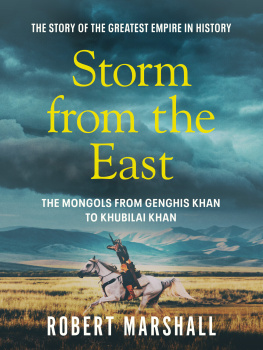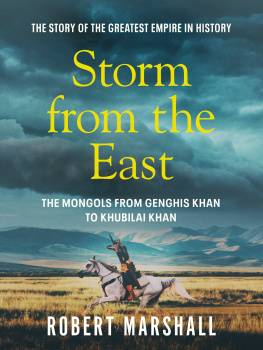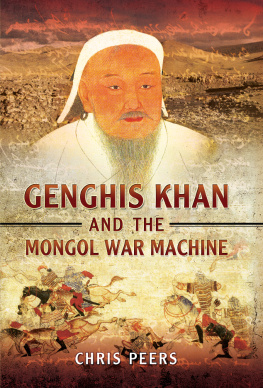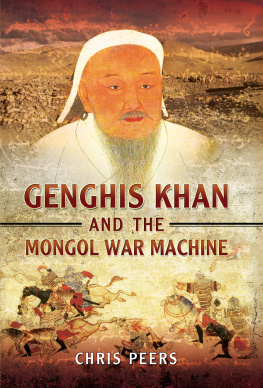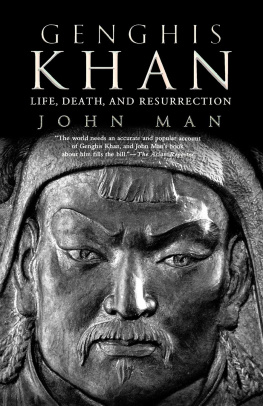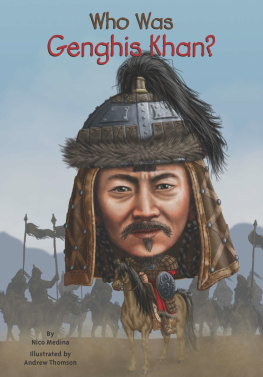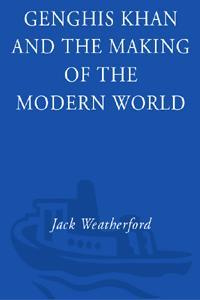Genghis Khan
BY THE SAME AUTHOR
France and the Jacobite Rising of 1745
The Jacobite Army in England
The Jacobites
Invasion: From the Armada to Hitler
Charles Edward Stuart
Crime and Punishment in Eighteenth-Century England
Stanley: The Making of an African Explorer
Snow Upon the Desert: The Life of Sir Richard Burton
From the Sierras to the Pampas:
Richard Burtons Travels in the Americas, 186069
Stanley: Sorcerers Apprentice
Hearts of Darkness: The European Exploration of Africa
Fitzroy Maclean
Robert Louis Stevenson
C. G. Jung
Napoleon
1066: The Year of Three Battles
Villa and Zapata
Wagons West: The Epic Story of Americas Overland Trails
1759: The Year Britain Became Master of the World
Lionheart and Lackland: King Richard, King John and the Wars of Conquest
Heroes and Villains
Marcus Aurelius: Philosopher, Emperor
The Burma Campaign
The Road Not Taken: How Britain Narrowly Missed a Revolution

Copyright 2015 by Frank McLynn
All rights reserved. No part of this publication may be reproduced, stored in a retrieval system, or transmitted, in any form or by any means, electronic, mechanical, photocopying, recording, or otherwise, without the prior written permission of the publisher. Printed in the United States of America. For information, address Da Capo Press, 44 Farnsworth Street, 3rd Floor, Boston, MA 02210.
Cataloging-in-Publication data for this book is available from the Library of Congress.
First Da Capo Press edition 2015
Reprinted by arrangement with Bodley Head, an imprint of Vintage Publishing
ISBN: 978-0-306-82396-1 (e-book)
LCCN: 2015939688
Published by Da Capo Press
A Member of the Perseus Books Group
www.dacapopress.com
Da Capo Press books are available at special discounts for bulk purchases in the U.S. by corporations, institutions, and other organizations. For more information, please contact the Special Markets Department at the Perseus Books Group, 2300 Chestnut Street, Suite 200, Philadelphia, PA 19103, or call (800) 810-4145, ext. 5000, or e-mail .
10 9 8 7 6 5 4 3 2 1
To the four important Ladies in my life: Pauline, Julie, Lucy, Ellen.
Contents
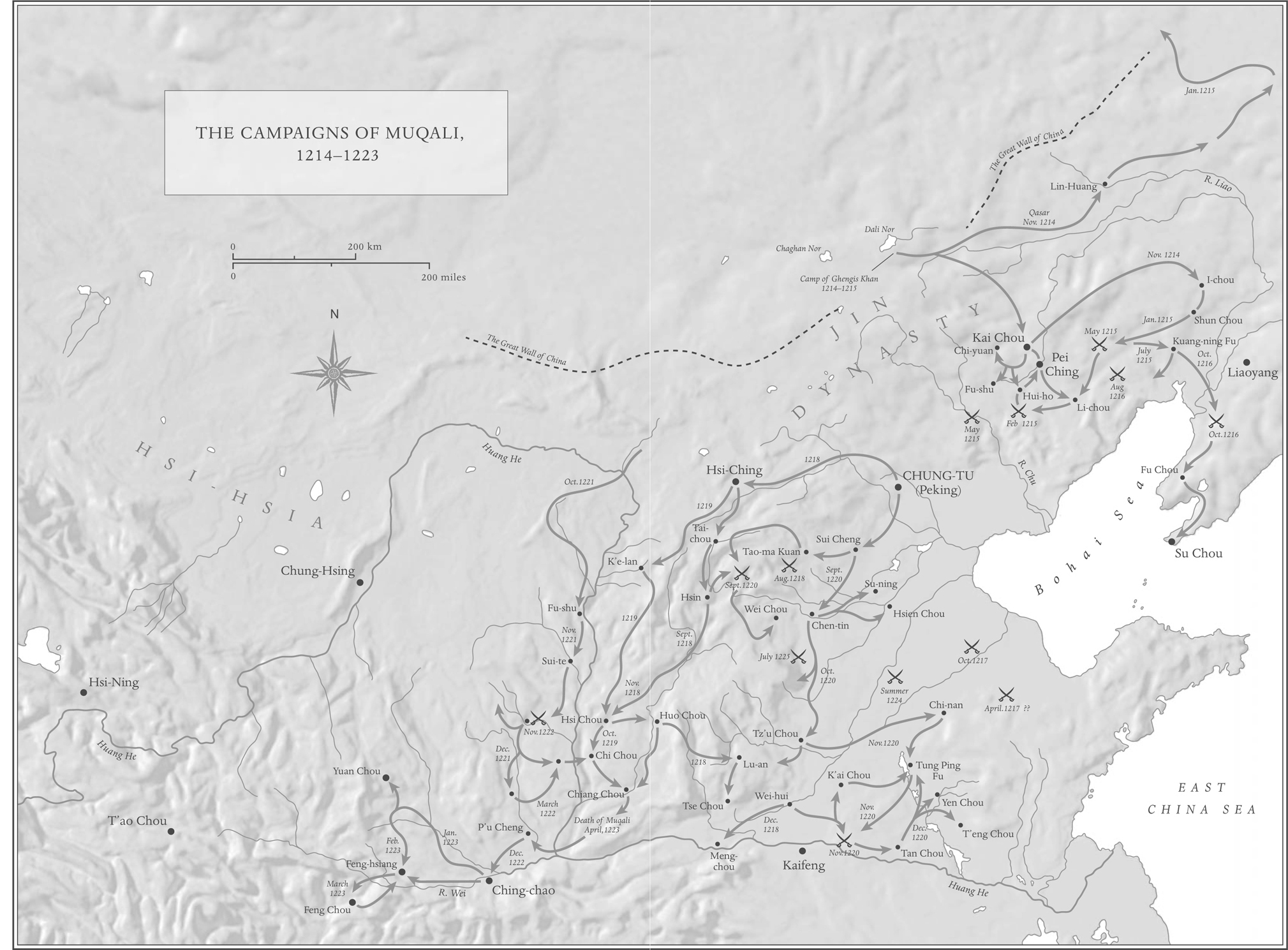
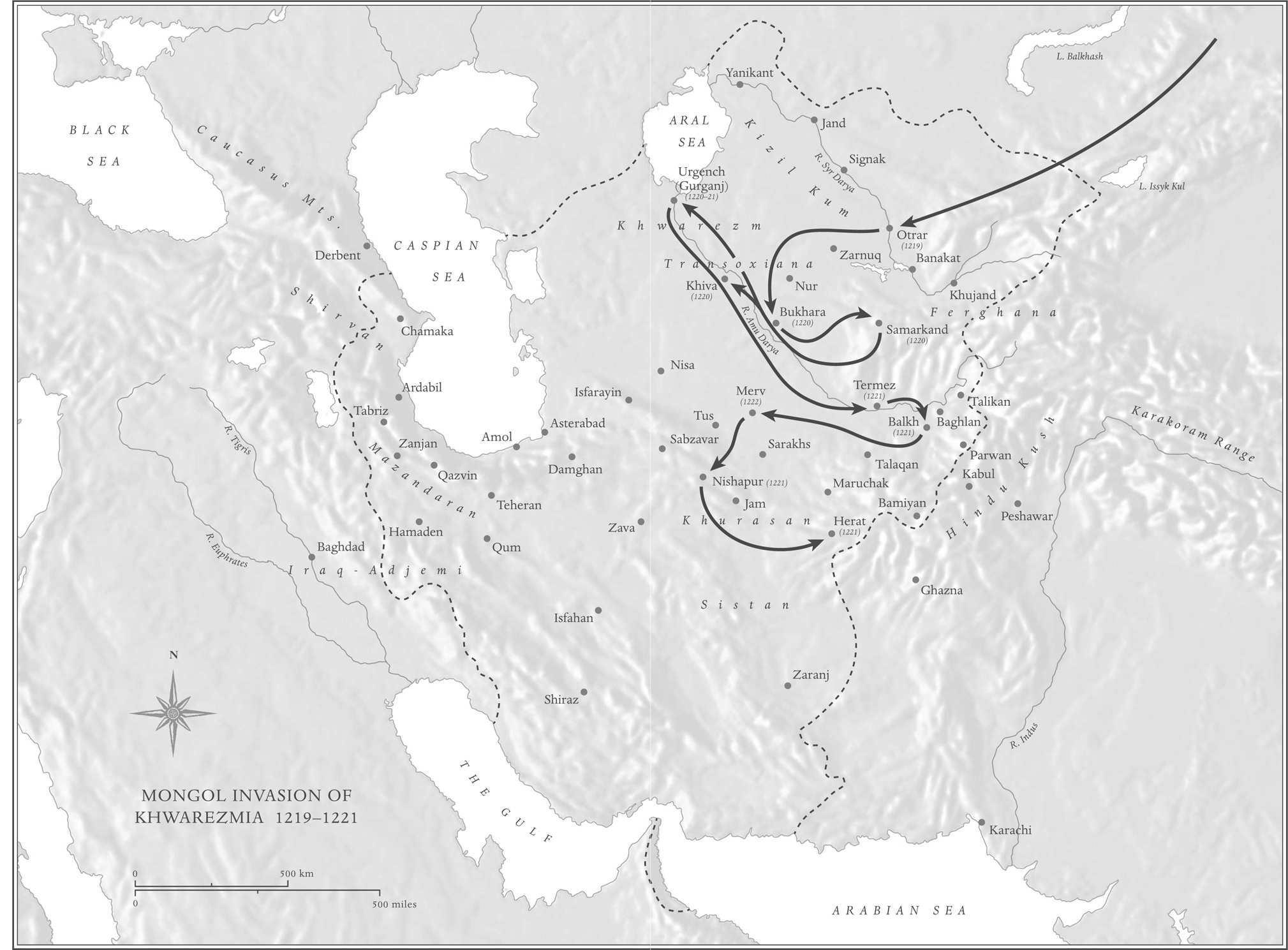
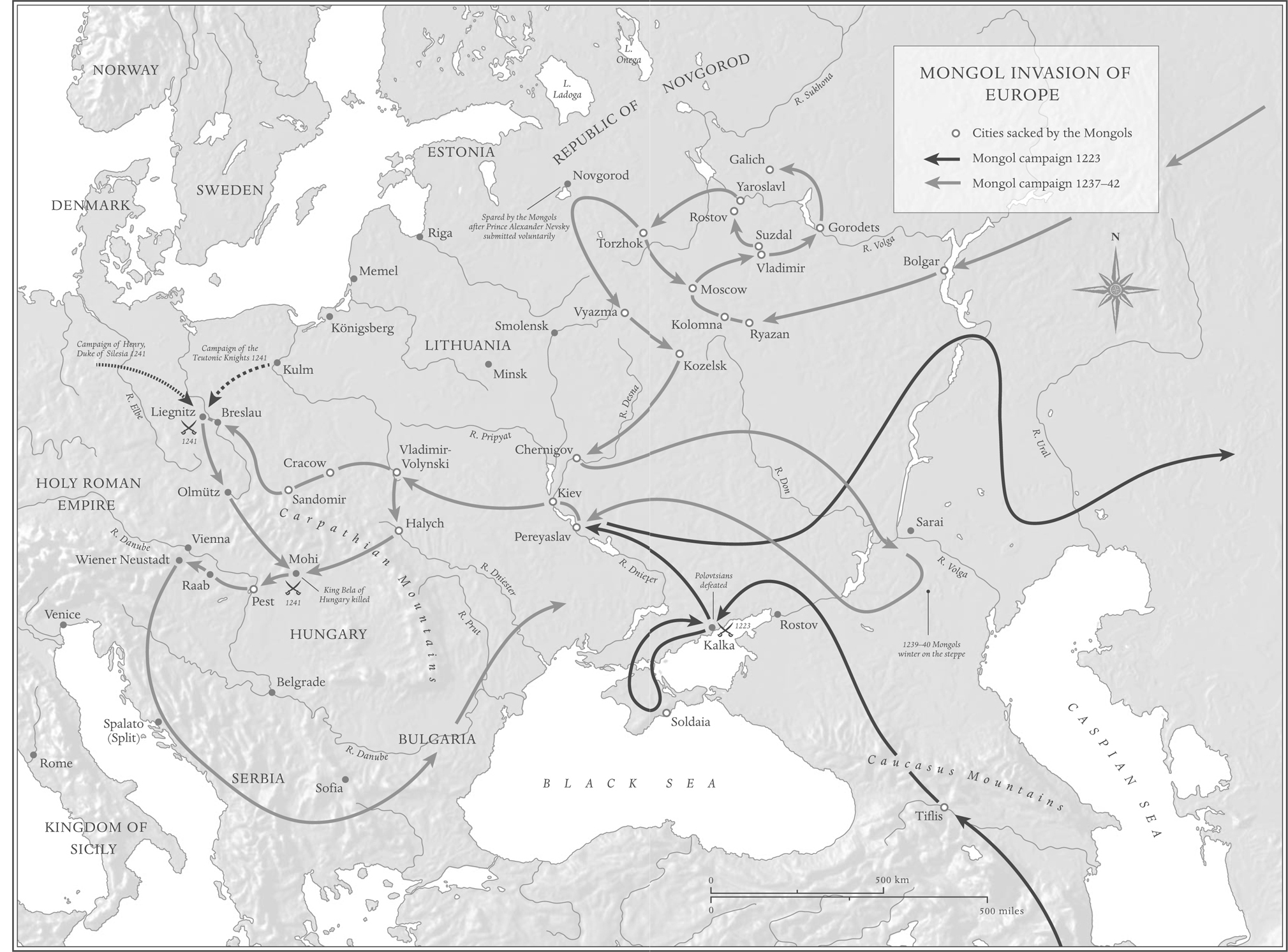
Page
(top) A Mongol yurt in steppe (Wikimedia); (bottom) Mongolian wild horse Equus przewalskii (Wikimedia)
Twin humped Bactrian camels in the Gobi Desert of Mongolia ( Dave Stamboulis / Alamy)
(top) Portrait of Genghis Khan cropped out of a page from an album depicting several Yuan emperors, located in the National Palace Museum in Taipei (Wikimedia); (bottom) Portrait of Ogodei Khan, located in the National Palace Museum in Taipei (Wikimedia)
Statue of Genghis Khan in Ulan Bator ( AGF Srl / Alamy)
Batu Khan depicted in a Persian book illumination. Illustration in Djamil el Tawarik (Compendium of Chronicles), a fourteenth-century Iranian work of literature and history attributed to Rashid al-Din and located in the Bibliothque Nationale, Paris (Photo: akg-images)
Genghis Khan in battle. Depicted in Djamil el Tawarik, attributed to Rashid al-Din (Bibliothque Nationale, Paris, France / Bridgeman Images)
The siege of Peking, 121314. Miniature painting from Rashid al-Dins Djamil el Tawarik, c. 1305 (Pictures From History / Bridgeman Images)
Genghis Khan fighting the Chinese in the mountains, a scene from Ahmad Tabrizis Shahanshahnamah, 133738 (Pictures From History / Bridgeman Images)
A sixteenth-century illustration of a fourteenth-century Persian story The History of the Mongols ( Heritage Image Partnership Ltd. / Alamy)
The Mongol siege of Baghdad, 1258. Rashid al-Din, Djamil el Tawarik, c. 1305 (Pictures From History / Bridgeman Images)
Prince Michael of Chernigov at the camp of Batu Khan by Vasily Smirnov, 1883 ( Heritage Image Partnership Ltd. / Alamy)
Battle between the Russian and Tartar troops in 1380 (oil on canvas), Russian School, 1640s (Art Museum of Yaroslavl, Russia / Bridgeman Images)
(top) Mongols at the wall of Vladimir attributed to Vasily Maksimov (18441911) (Wikimedia); (bottom) Nineteenth-century portrait of Henry II of Poland attributed to Jan Matejko (Wikimedia)
(top) The Mongol army defeats the combined forces of Poles, Czechs and Germans at Liegnitz in 1241, from Legend of Saint Hedwig (ink on vellum), European School, fourteenth century (Museum of the Battle of Legnica, Poland /Ancient Art and Architecture Collection Ltd. / Kadokawa / Bridgeman Images); (bottom) The Mongol Invasion of Hungary in 1241 during the reign of Bela IV (colour litho of an original coloured wood engraving), Hungarian School, fifteenth century (Private Collection / Archives Charmet / Bridgeman Images)
The escape of King Bela IV (oil on canvas) by Mr Than, 1882. Located in Hungarian National Gallery, Budapest (Photo: akg-images)
The Mongols led by Batu Khan into the Battle of the Danube, miniature from a manuscript (French Codex 2623 folio 29). Located in sterreichische Nationalbibliothek (De Agostini Picture Library / Bridgeman Images)
N.B. almost all dates in early Mongol history are somewhat conjectural.
ALAQUSH (d. 1212). Chief of the Ongud. Revealed the Naiman plan of attack to Genghis in 1205. Assassinated by a rival faction in the Ongud while Genghis was in China.
ALTAN (dates unknown). Third son of Qutula. Pretender to the khanate. Jealous of Genghis, his cousin, and habitually and systematically treacherous. Said to have alienated Jamuga from Genghis.
AMBAGHAI (reigned 11491156), of the Tayichiud clan. Khan of the Mongol confederation. Crucified by the Jin Chinese.
ARSLAN (dates unknown). Chief of the Qarluqs, who lived in the region of the Black Irtysh. Formerly a vassal of Qara Khitai, he defected to Genghis in 1211.
ASA GAMBU (d. 1227). Anti-Mongol Tangut noble, appointed both prime minister and commander-in-chief by emperor Hsien-Tsung of Hsi-Hsia (reigned 12231226).
BARCHUQ (d. after 1227), the idiqut or ruler of the Uighurs. Switched allegiance from Qara Khitai to Genghis in 1209 and was given one of his daughters in marriage. One of Genghiss most trusted and valued allies. Fought in the Tangut campaign of 1227.
BATU (c. 12071255). Son of Jochi and founder of the Golden Horde dynasty. Commander-in-chief of the Mongol invasion of Europe in 123642. Loathed the great khan Guyuk and was close to civil war with him when Guyuk died. Allied with Sorqoqtani Beki to secure Mongkes election.
BEGTER (c. 11561180). Son of Yesugei and his (unknown) first wife. Genghiss half-brother but murdered by him.
BELGUTEI (c. 1158c. 1252). Brother of Begter and Genghiss half-brother. Remained scrupulously loyal to Genghis and performed well as a general, though was notably indiscreet and thus excluded from the Mongol council and top-level decision-making.
BOORCHU (c. 11621227). First and most loyal of Genghiss friends. One of the four steeds. Saved Genghiss life and was a notable general. Particularly close to Ogodei. Died during the Tangut campaign of 1227, possibly of Parkinsons disease or maybe complications arising from epilepsy or Mnires disease.
Next page


